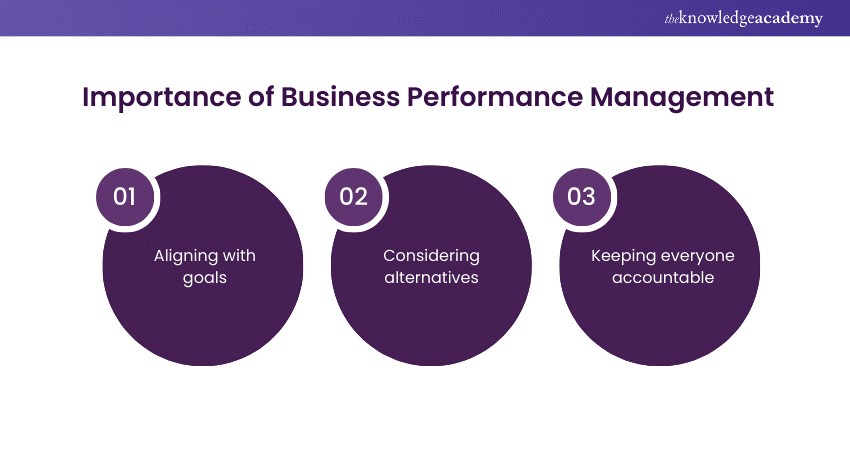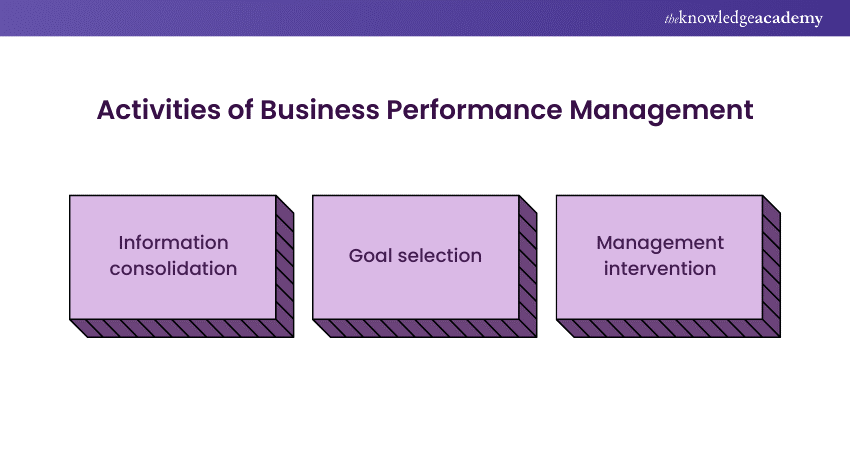We may not have the course you’re looking for. If you enquire or give us a call on +1 7204454674 and speak to our training experts, we may still be able to help with your training requirements.
Training Outcomes Within Your Budget!
We ensure quality, budget-alignment, and timely delivery by our expert instructors.

Businesses often rely on the performance of their employees for better results and their success. However, it is impossible to maintain the same enthusiasm among employees towards work, which can negatively impact the organisation’s performance as a whole. This is where Business Performance Management comes in.
Business Performance Management is streamlines approach to monitor, analyse, and enhance an organisation's performance to achieve its objectives. Thus, it is crucial to learn about this approach and thrive in the competitive business environment.
Don't know where to begin from? Worry no more, this blog is for you. Read this blog to learn everything about Business Performance Management, including its importance, types and cycle. Also, explore the activities conducted during its implementation.
Table of Contents
1) What is Business Performance Management?
2) Why is Business Performance Management important?
3) Types of Business Performance Management
4) The Business Performance Management Cycle
5) Three main activities of Business Performance Management
6) Conclusion
What is Business Performance Management?
Business Performance Management (BPM) is a strategic approach that enables organisations to monitor and manage their performance effectively. It includes various processes to ensure alignment with strategic objectives, including goal setting, monitoring, analysis, and optimisation. Using Key Performance Indicators (KPIs) and metrics, Business Performance Management provides insights into the health and efficiency of business operations.
By consistently monitoring and analysing, organisations can pinpoint improvement areas, enabling informed decision-making to boost performance. Through Business Performance Management, companies make informed decisions, staying agile in dynamic markets. Today, BPM has become a guiding framework that enables organisations to achieve their goals.
Why is business Performance Management important?
Business Performance Management holds significant importance for organisations due to the following key reasons:

1) Aligning with goals
By systematically evaluating performance metrics across departments and functions, Business Performance Management ensures that every aspect of the business contributes effectively to the organisation's overarching goals. This alignment facilitates better decision-making and resource allocation, as resources can be directed towards activities that directly support strategic priorities.
Moreover, Business Performance Management enables organisations to adapt quickly to changing market conditions by continuously monitoring performance and adjusting strategies as needed. By fostering a culture of goal alignment and accountability, BPM enhances the organisation's capacity to excel and stay ahead in the market.
2) Considering alternatives
Business Performance Management facilitates well-informed decision-making by analysing decisions and strategies and improving performance with various insights. Through comprehensive data analysis and performance evaluation, organisations can identify inefficiencies, problems, and areas for improvement across different business processes.
By exploring alternative approaches, Business Performance Management enables organisations to optimise their operations, enhance productivity, and mitigate risks effectively. This proactive decision-making equips businesses to respond and capitalise on opportunities in dynamic, competitive markets. Thus, it helps ensure persistence and success.
3) Keeping everyone accountable
Business Performance Management imparts accountability, clarifying roles, responsibilities, and performance expectations for individuals and departments within organisations. Defining clear metrics and performance indicators provides a framework for evaluating individual and collective contributions towards organisational goals.
Further, transparency cultivates accountability, prompting employees to take ownership and pursue excellence in their organisational roles. By encouraging transparent communication and collaboration, Business Performance Management motivates teams to pursue shared goals, thereby boosting organisational performance.
Elevate your career with our Performance Management Training – register today!
Types of Business Performance Management
Now that you know Business Performance Management definition, it is time to understand its various types:

1) Financial Performance Management
Financial Performance Management involves analysing, monitoring, and optimising financial metrics and outcomes within an organisation. It encompasses budgeting, estimating, financial reporting, variance, and profitability analysis. Organizations utilise Financial Performance Management for resource allocation, goal achievement, and strategic decision-making based on financial insights.
2) Operational Performance Management
Operational Performance Management targets efficiency and effectiveness in organisational processes. It involves monitoring key metrics, identifying improvement areas, and implementing enhancements to align with goals. This approach aids in cost reduction, productivity enhancement, and delivering superior products or services to customers.
By prioritising operational metrics and strategic objectives, organisations drive continuous improvement. It serves as a framework to streamline operations, optimise processes, and elevate performance. With a focus on KPIs and ongoing refinement, businesses achieve greater efficiency, effectiveness, and customer satisfaction.
3) Strategic Performance Management
Strategic Performance Management involves aligning organisational objectives with strategic priorities and monitoring performance against long-term goals. It encompasses strategic planning, goal setting, performance measurement, and strategic alignment. Organisations utilise strategic Performance Management to ensure alignment with their strategic direction.
4) Employee Performance Management
Employee Performance Management focuses on managing and improving the performance of individual employees within an organisation. Business Performance Management involves the following:
a) Setting expectations
b) Offering feedback
c) Coaching
d) Evaluating performance
e) Addressing training needs
f) Rewarding high performance to improve growth effectively
Effective employee Performance Management helps organisations enhance employee engagement, motivation, and productivity. This, in turn, leads to better organisational Performance.
5) Customer Performance Management
Customer Performance Management involves understanding customer-facing processes and interactions. It strives to improve customer satisfaction, loyalty, and retention. Business Performance Management involves collecting and analysing customer feedback. It measures satisfaction and loyalty metrics and identifies areas for improving the customer experience.
Finally, it implements initiatives addressing customer needs and preferences. Organisations use customer Performance Management to build strong customer relationships, increase lifetime value, and drive business growth.
Unleash your team's full potential with our Introduction to Managing People Training - join now!
The Business Performance Management Cycle
Business Performance Management Cycle consists of the following four stages:

1) Evaluate and plan
In this initial stage of the Business Performance Management Cycle, organisations comprehensively assess their current Performance levels. They cautiously define their short-term and long-term goals and create strategic plans to attain them.
This stage establishes the planning for the entire BPM process, ensuring clarity in direction and alignment of efforts across the organisation. Establishing clear objectives and outlining necessary steps leads organisations toward success and sustainable growth, encouraging competitive advantage.
2) Monitor performance metrics
Once goals are set, organisations embark on a continuous journey of monitoring performance metrics and KPIs. Through real-time data analysis, they keep monitoring progress, swiftly identifying areas of strength and weakness.
This proactive approach enables timely decision-making and adjustments, ensuring that organisational efforts remain aligned with strategic objectives. Closely monitoring performance metrics provides insights for informed decisions, helping organisations to sustain competitive advantage in dynamic markets.
3) Review and analyse
Organisations regularly conduct thorough reviews and analyses of performance data to gain deeper insights into trends, patterns, and Performance drivers. This stage assesses achievements against targets and explores deviations from expected outcomes, supporting strategic alignment and improvement.
By delving into the root causes of these deviations, organisations can identify opportunities for improvement and refine their strategies accordingly. Through rigorous review and analysis, organisations gain a deeper understanding of their performance dynamics. This enables them to base decisions on data and adjust to market changes with agility and precision.
4) Improve and repeat
Building upon the insights gained from the review and analysis stage, organisations start a journey of continuous improvement and refinement. They implement corrective actions and process enhancements to address identified areas of improvement and ensure lessons learned are easily integrated into future planning and execution.
Organisations promote ongoing improvement to achieve success, adaptation, and growth. They adapt to evolving market dynamics through iterative improvement cycles and grab emerging opportunities, keeping them ahead in today's fast-paced Business landscape.
Unlock the key to achieving excellence in every aspect with our Senior Management Training.
Three main activities of Business Performance Management
Three main activities of Business Performance Management include the following:

1) Information consolidation
Information consolidation serves as the foundation of effective decision-making within an organisation. Beyond data gathering, it organises, synthesises, and analyses information from various sources like financial reports and customer feedback.
By integrating data from various departments and systems, businesses can gain holistic insights into their performance. This comprehensive view enables stakeholders to identify patterns, trends, and correlations that inform strategic decisions and operational improvements.
Moreover, organisations can use advanced analytics and data visualisation tools to transform raw data into actionable insights. This can empower decision-makers at all levels to drive Performance excellence.
2) Goal selection
Goal selection is a strategic process that considers an organisation's mission, vision, and overall goals. Beyond simply setting goals, this activity involves aligning them with the organisation's core values, competitive landscape, and market dynamics.
Through collaborative discussions and stakeholder engagement, businesses can define SMART goals that serve as clear benchmarks for Performance evaluation. Moreover, goal selection involves prioritising objectives based on their strategic significance. This process considers the potential impact on key stakeholders.
This helps ensure focused efforts and resource allocation. Organisations can foster alignment, accountability, and a shared sense of purpose across the workforce by establishing a logical framework of goals.
3) Management intervention
Management intervention is a proactive approach to addressing performance gaps and driving continuous improvement within an organisation. In addition to reacting to deviations, this involves proactively using real-time data and analytics to anticipate challenges and opportunities.
By adopting a systematic problem-solving approach, management identifies root causes, evaluates alternatives, and implements targeted interventions to optimise performance. This may involve the following:
a) Utilising Agile methodologies
b) Encouraging a culture of experimentation
c) Empowering frontline employees to contribute innovative solutions
Furthermore, effective management intervention requires ongoing monitoring and feedback mechanisms to track progress, adjust strategies, and ensure alignment with objectives. Organisations adapt to changing market conditions through timely and determined actions, mitigate risks, and sustain competitive advantage in dynamic environments.
Conclusion
Optimising organisational performance through Business Performance Management is vital for achieving strategic objectives. By adopting a systematic Performance Management approach, organisations can navigate market changes and maintain long-term success in competitive Business environments.
Take the next step: invest in Personal and Organisational Development today!
Frequently Asked Questions

The three main activities in Business Performance Management are evaluation and planning, monitoring Performance metrics, and reviewing and analysing data. These activities involve assessing current performance, tracking progress, and gaining insights.

The role of a Business Performance Manager involves overseeing the entire Business Performance Management Cycle. This includes evaluating current performance, setting goals, monitoring metrics, analysing data, implementing improvements, and ensuring alignment with strategic objectives.

The Knowledge Academy takes global learning to new heights, offering over 30,000 online courses across 490+ locations in 220 countries. This expansive reach ensures accessibility and convenience for learners worldwide.
Alongside our diverse Online Course Catalogue, encompassing 17 major categories, we go the extra mile by providing a plethora of free educational Online Resources like News updates, Blogs, videos, webinars, and interview questions. Tailoring learning experiences further, professionals can maximise value with customisable Course Bundles of TKA.

The Knowledge Academy’s Knowledge Pass, a prepaid voucher, adds another layer of flexibility, allowing course bookings over a 12-month period. Join us on a journey where education knows no bounds.

The Knowledge Academy offers various blogs on Management Courses, including Time Management Training, Active Listening Training, Stress Management Course and more. These courses cater to different skill levels, providing comprehensive insights into Career Management.
Our Business Skills cover a range of topics related to Personal Development, offering valuable resources, best practices, and industry insights. Whether you are a beginner or looking to advance your Management skills, The Knowledge Academy's diverse courses and informative blogs have you covered.
Upcoming Business Skills Resources Batches & Dates
Date
 Managing Remote Teams
Managing Remote Teams
Fri 10th Jan 2025
Fri 14th Feb 2025
Fri 11th Apr 2025
Fri 23rd May 2025
Fri 8th Aug 2025
Fri 26th Sep 2025
Fri 21st Nov 2025







 Top Rated Course
Top Rated Course



 If you wish to make any changes to your course, please
If you wish to make any changes to your course, please


